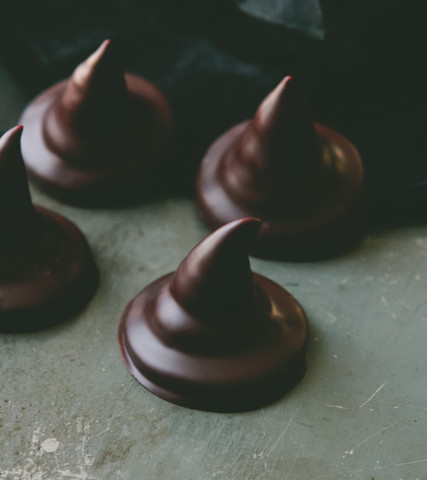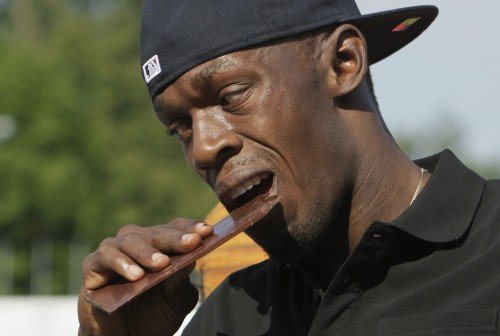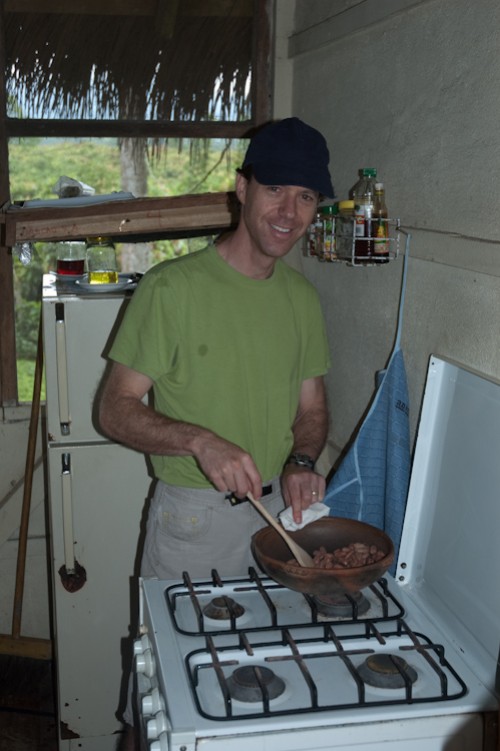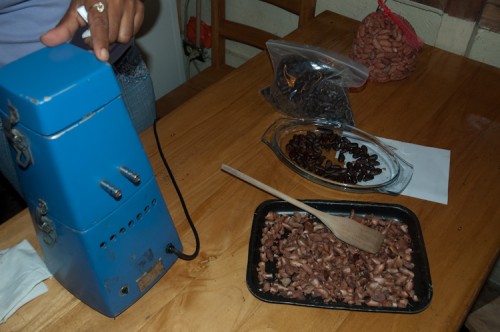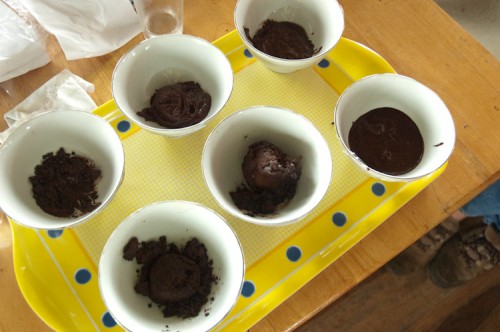Level Up Your Chocolate Game This Halloween

[Image: Halloween Candy by whistlepunch]
According to a survey conducted by the National Confectioners Association, candy sales are expected to reach $2.5 billion this Halloween season. While we often think of Halloween candy as varied and available in seemingly endless quantities, it lacks a certain diversity – just 3 companies (Mars, Hershey’s, and Nestlé) produce 99.4% of snack-sized chocolates sold in the US. Most industrially produced candy also lacks chocolate content – the FDA only requires that milk chocolate be 10% by weight of chocolate liquor (the chocolatey tasting part of the cocoa bean). The number one ingredient in Halloween candy is, more often than not, sugar, with a cocktail of milk, corn syrup, palm kernel oil, and artificial flavors holding it together.
There are a number of fine and craft chocolate confections on the market reminiscent of the Halloween candy central to our champion trick-or-treater youths. They’re not always available in snack-sized portions, but what they might lack in individual wrapping they more than make up for in flavor. If you’re interested in having some chocolate that, well, has chocolate in it, here are my recommendations to help you make this Halloween season a game-changer.

[Image: Burdick Chocolate Ghosts]
Love Hershey’s Reese’s Peanut Butter Cups? Just wait ‘til you try:
Alma Chocolate’s Salted Peanut Butter Cups
Chocolopolis Peanut Butter Tortoises
Recchiuti Peanut Butter Pucks
Patric Chocolate PBJ OMG bars
Hershey’s Almond Joy Bars
Fran’s Chocolate Coconut Gold Bars
EHChocolatier Coconutty Bars
Madre Chocolate Spiced Coconut Pecan Bars
Hershey’s Mounds Bars
Chocolopolis Coconut Meltaways
Mars’ Snickers Bars
Xocolatl de David Raleigh Bars
Chocolopolis Dark or Milk Chocolate Salted Peanut Turtles
Hershey’s Assorted Miniatures (Mr. Good and Krackel)
Taza Chocolate Tazitos Mini Bars, Crispy Crunch and Peanut Crunch
Michel Cluizel Dark Chocolate with Crispy Pearls and Cinnamon Bars
Chocolopolis Salty Nutty Bar
Valrhona Caramelia with Crunchy Pearls and Milk Chocolate
Mars Three Musketeers Bars
EHChocolatier Chocolate Chew Bars
Hershey’s York Peppermint Patties
Recchiuti Peppermint Thins
Fran’s Chocolate Mint Thins
Michel Cluizel Dark Chocolate with Crystallized Fresh Mint Leaves Bar
Nestlé Raisinets
Domori Chocolate Covered Raisins
Ferrero Rochers
Guido Gobino Gianduiotti
Hershey’s Rolos
Fran’s Chocolate Salted Caramels
EHChocolatier Salted Caramels
Black Dinah Chocolatiers Flagship Caramels
Xocolatl de David Salted Caramel Bars
Hershey’s HEATH Bars
EHChocolatier Toffee Almond
Alma Chocolate Salty Nutty Toffee Mini Bar
Pop Rocks Candies
Cocanu Moonwalk 65% Dark Chocolate, Cacao Nibs, and Pop Rocks
Chuao Chocolatier’s Firecracker Bars
Hershey’s Whoppers
Recchiuti Confections Malted Dark Milk Revolution
Halloween-inspired confections, for when the candy needs to look like Halloween
Burdick Chocolate Ghosts
EHChocolatier Witch Hats
EHChocolatier Spooky Bonbons
Recchiuti Confections Whooligans
John & Kira’s Chocolate Pumpkins and Apples
If you experience sticker shock while exploring these options, consider this: these are not candies that are cheap by design, ready to be tossed in a pillowcase and stashed under your childhood bed, but rather artisan products produced by skilled craftspeople. Plus more chocolate content necessarily requires a higher price point. Keep in mind, too, that these chocolate confections might cost more than you’re accustomed to, but cocoa farmers aren’t getting rich. This is a question of quality and labor value and, with all products, you get what you pay for.
Happy Halloween!
[Image: EHChocolatier Witch Hats]
Chocolate Books of 2012
While 2011 was a busy year for publishing on chocolate (see last year’s summary list here), 2012 ushered in a dizzying array of chocolate-related books from multiple genres. Below, you’ll find my picks for several of the best, as well as some from my to-read list.
If there are other recently published books that you don’t see listed here, I would love to hear your recommendations.
Note: It is the case with many of the chocolate cookbooks listed below that they will teach you surprisingly little about cacao and chocolate (and some of it will even be wrong). By all means, get chocolate-centric cookbooks for the recipes and inspiration, then couple them with a text that focuses on source ingredients cacao and chocolate like Presilla’s The New Taste of Chocolate: A Cultural & Natural History of Cacao with Recipes for a more meaningful introduction to the topic.
Happy reading!
Cookbooks/Technique books
Gran Cocina Latina: The Food of Latin America
2012 brought us another masterpiece from award-winning chef and scholar Maricel Presilla — Gran Cocina Latina. This cookbook, with more than 500 carefully researched recipes from Latin America, spans the genres of culinary history and ethnography. An entire section of the book is devoted to cacao and chocolate. It is of interest to chefs, home cooks, food travelers, and scholars.
The Elements of Dessert
A must read for hardcore pastry and cooking science geeks, this beautiful cookbook from celebrated pastry chef Francisco Migoya has over 200 recipes for exquisite, elaborate modern desserts.
Chocolates and Confections: Formula, Theory, and Technique for the Artisan Confectioner
This text is a standard for pastry chefs, bakers, and chocolatiers, now in its second edition. It has been significantly expanded and revised to include new recipes, formulas, and business advising sections.
Bouchon Bakery
This book has been everywhere this year — prominently displayed in bookstores, on several “best of” lists, and occasionally even selling out on Amazon. The praise is well-deserved, as the recipes, mixed with fun anecdotes from Keller, are instructive and scrumptious. The photography and design make the book worthy of coffee table fame, if you can tolerate the looking without cooking.
The Blue Bottle Craft of Coffee: Growing, Roasting, and Drinking, with Recipes
A book not about chocolate, but another celebrated bean — coffee. This is an excellent, instructive text that takes the reader from coffee plant to tastebud. To the best of my knowledge, a similar book does not exist in the craft chocolate world (Presilla’s comes closest, perhaps), but one should.
Original 1896 Boston Cooking-School Cook Book
A reprint of an American classic, of interest and use for almost all home kitchens. Historical chocolate recipes, too!
Professional Baking
The sixth edition of a canonical educational text on baking.
Sugar and Spice: Sweets and Treats from Around the World
Gaitri Pagrach-Chandra is an award-winning food historian and writer. In this text, she has collected over 120 clear recipes for sweet treats from around the world. Stories and images make this book equal parts good read and useful cookbook.
The Liddabit Sweets Candy Cookbook: How to Make Truly Scrumptious Candy in Your Own Kitchen!
For DIY enthusiasts and candy lovers, this cookbook from the popular Liddabit Sweets brand clearly explains home candymaking with fun flavor twists. The photos are lovely and instructive, and the authors’ humor is entertaining.
Luscious Chocolate Desserts
For the reader who wants alluring pictures and mouthwatering, well-tested chocolate recipes designed for home cooks, this cookbook from Lori Longbotham, a former food editor at Gourmet, does not disappoint. 65-plus recipes, clear instructions, and easily-located ingredients make this ideal for someone obsessed with chocolate but new to cooking with it.
I’m Dreaming of a Chocolate Christmas
Award-winning chef and pastry chef Marcel Desaulniers provides 72 delectable chocolate Christmas recipes for home cooks. Includes a section on packing and shipping treats as gifts.
Rococo: Mastering the Art of Chocolate, Chantal Coady
Rococo is an elegantly branded product line from one of Britain’s top chocolatiers, Chantal Coady. In this exquisitely designed book, Coady tells the story of her business and provides a selection of plainly written recipes. Also great for display and gifting.
Chocolate to Savour, Kirsten Tibballs
Kirsten Tibballs, Australian chocolatier, pastry chef, Callebaut representative, and founder of the Savour Chocolate and Patisserie School in Melbourne, offers plainly written recipes for enthusiasts in this debut cookbook.
Patrick Roger, en quète de chocolat, Patrick Roger, Jean-Marc Dimanche
Eccentric French chocolatier Patrick Roger has here collected stunning photographs of some of his most celebrated chocolate sculptures, from an exhibit series that illustrates the dangers of deforestation to animals. These remarkable works of chocolate art feature orangutans, gorillas, polar bears, elephants, and more. In French.
Chocolat Café, Pierre Marcolini
Belgian chocolatier Pierre Marcolini has produced a cookbook that brings together chocolate and coffee. The text has recipes, photos, advice on chocolate and coffee pairing, and stories from Marcolini’s life. In French.
Chocolat, Christophe Felder, Domitille Langot
Noted French pastry chef Christophe Felder’s enormous cookbook has approximately 200 recipes for chocolate and pastry, ranging from simple to challenging, traditional to innovative. Felder offers advice on tasting, flavor pairing, and working with chocolate. A good fit for pastry chefs and adventurous home cooks. In French.
Chocolat Menier, Vincent Boué, Hubert Delorme, Didier Stéphan, Héloïse Martel
This cookbook is the stuff of nostalgia for any who grew up eating Menier chocolate. Nearly 300 easy-to-make classic recipes for the home cook. In French.
Nonfiction
Raising the Bar: The Future of Fine Chocolate
Author, entrepreneur, and educator Pam Williams has long been a leader in the chocolate industry. (Regular readers will note that I took an online course at her school, the Ecole Chocolat.) Jim Eber, her co-author, is a specialist in food and business marketing. In this important text, they survey the current state of the chocolate industry — from cacao genetics to farms to marketing to the art of the chocolatier. A must-read for the serious chocolate geek.
Chocolate Islands: Cocoa, Slavery, and Colonial Africa
This travel narrative from historian Catherine Higgs traces the travels of Englishman Joseph Burtt, hired by Cadbury Brothers Limited to investigate claims of forced labor on the cacao plantations of Sao Tome and Principe, through Africa. Burtt’s early twentieth century “fieldwork experience” of sorts, and subsequent slow, but deliberate reporting on the abuses he witnessed played a role in influencing a number of important changes in African labor practices and chocolate industry ethics. (This history is detailed in different form in Lowell J. Satre’s Chocolate on Trial: Slavery, Politics, and the Ethics of Business) An important read for those interested in chocolate industry ethics, labor rights, African studies, and history of chocolate.
Taste Matters: Why We Like the Foods We Do
How do genes, maternal diet, culture, and physiology affect taste? Prescott ponders these questions in this fascinating, well-researched book. Interesting as much for the information it provides as for the potential it demonstrates for public health causes.
Coffee Life in Japan (California Studies in Food and Culture)
This book isn’t about chocolate, but it is about coffee culture, which presents interesting parallels and contrasts. A carefully researched, thoughtfully written history-ethnography-memoir about the experience of coffee in Japan.
Chocolate in Health and Nutrition (Nutrition and Health)
If ever there was an argument for keeping libraries well-funded, this book is one. Try to borrow it from the library if you can. (A WorldCat search shows where to find it.)
An academic text with a very high price point, this text is unique in its broad level scholarly, data-driven treatment of the research on chocolate and health.
The Science of Ice Cream
For ice cream professionals and serious enthusiasts, this book will not so much teach you how to make ice cream as about the science behind how ice cream is made.
On the Chocolate Trail: A Delicious Adventure Connecting Jews, Religions, History, Travel, Rituals and Recipes to the Magic of Cacao
Rabbi Deborah R. Prinze traces the historical connections between Jews, religion, and chocolate in this unique text. While at times the links drawn are slightly overstated, the author’s passionate writing makes for a fun introduction to the topic.
Chicago’s Sweet Candy History (Images of America)
A book of photographs with trivia mixed in, this is an enjoyable way to picture 150 years of Chicago’s confectionery history.
The Trebor Story: How a Tiny Family Firm Making Sweets in London’s East End Became Britain’s Biggest Sugar Confectioner, Creating Iconic Brands Before Selling to Cadbury and Later Kraft Foods, Matthew Crampton
The lengthy title more or less summarizes this book, written by a fan of the Trebor family business in an engaging style. Of interest to those studying business or confectionery history.
Du Cacao et Des Hommes, Voyages Dans le Monde du Chocolate, Alfred Conesa
French researcher Alfred Conesa spent six years traveling the world investigating cacao and the lives of people who care for it. His resulting book is organized in two parts – the first describes the history of the cacao tree, the second traces the metamorphosis of cacao fruit from its first indigenous uses to present day popularity. The book is illustrated with artwork by cacao producers. Of interest to anthropologists, historians, agronomists, indigenous studies scholars, and serious chocolate enthusiasts. In French.
Fiction
Peaches for Father Francis: A Novel
The third book in the best-selling Chocolat series, this story takes Vianne Rocher back to Lansquenet, the French village where readers first learned of her magical chocolates. While Harris’ descriptive style itself relies on stereotype, her writing makes the heavy themes of religious and cultural tolerance easy to stomach, and provides a heartwarming emphasis on the importance of food and chocolate to building community.
The Chocolate Thief
Paris, chocolate, romance, comedy — a fun read all around.
Sorcery and Cecelia or The Enchanted Chocolate Pot
A period drama fantasy, one reviewer aptly summed up this book’s style as “Jane Austen meets J.K. Rowling.” Plus there’s talk of an enchanted chocolate pot. An entertaining read for young (and young at heart) adults.
Palmeras en la nieve, Luz Gabas
Moving between colonial and present-day Fernando Pó (now called Bioko), the northernmost part of what is now Equatorial Guinea, the only Spanish-speaking African country, this novel is part dramatic intercultural love story, part ode to the magic of growing some of the world’s top cacao. The cacao is named Sampaka, just like the Barcelona-based company Cacao Sampaka (see what the author did there?). In Spanish.
Children’s Fiction
Sweet Coco: Chocolate Maker’s Apprentice
Perhaps the only children’s book to describe the process of taking cacao from bean to bar chocolate, following a young girl’s magical journey with her favorite chocolate maker. I found the story and rhyming cloying at times, but the book is nevertheless instructive and well-designed.
Too-Loose the Chocolate Moose, 30th Anniversary Edition
It’s not easy being a moose made of chocolate. This millenial childhood classic has been rereleased for its 30th anniversary.
Mercedes and the Chocolate Pilot
A moving, if somewhat romanticized, account of Operation Little Vittles, a candy drop initiative carried out by an American pilot during the Berlin Airlift of 1948-1949.
La fabuleuse histoire du gâteau au chocolat!, Orianne Lallemand
This colorfully illustrated children’s story tells the tale of a troublesome dragon wooed by chocolate cake (with recipe). In French.
Film
Romantics Anonymous
Ok, it’s not a book, but this French film is a delight! If you love chocolate, introverts, romance, and laughter, you must see it. In French with English subtitles.
What’s next on my chocolate reading list?
The Economic History of the Caribbean since the Napoleonic Wars
Are Cat Ears Made of Chocolate?: A Children’s Rhyme
Milton Hershey: Chocolate Man, script for theater
Better Than Chocolate (Life in Icicle Falls)
Chocolat chaud au parfum de nougat miel, Voltaire, Christophe Michalak
In French.
Cacao, Michèle Kahn
In French.
Chocolate Olympics 2012

Jamaican runner Usain Bolt strikes his signature lightning bolt pose with Olympic mascot Wenlock and mini-stuffed-Wenlock after winning gold in the 100m.
If you were like me and followed the London 2012 Olympics with great enthusiasm, chances are that you’re feeling a bit of a void in your life now that the Games are over. So here’s a retrospective of a story that NBC didn’t cover: the chocolate Olympics.
Chocolate sponsorship
Kraft/Cadbury was an “official sponsor” and the “official treat provider” for the London games, the only chocolate company allowed that status (Mars was the “official chocolate” of Beijing 2008), and launched a 50 million pound marketing campaign as a result. The campaign included printing the London 2012 logo on Cadbury products, selling chocolates made in the shape of the rather odd Olympic mascots, and crafting a social media strategy to amp up support for Great Britain’s athletes.
In typical Cadbury fashion, the marketing was quirky. The interactive online tool “The Cadbury Choculator” allows users to generate Games statistics in chocolatey measurements. For example, I learned that “The London 2012 Olympic Swimming pool is 208 wonderful Cadbury Dairy Milk bars wide” and “In Olympic Trampolining the gymnasts perform tricks at whopping 500 Cadbury Crunchie bars high.”
Cadbury also returned to its stop motion Crème Egg video style for the Games with an Olympic-themed “Let the Goo Games Begin” campaign:
Other chocolate companies were unofficially involved with the Games, by sponsoring athletes as “brand ambassadors,” setting up treat stands around London, and releasing products in “the spirit of” the Olympics. Regulations around the use of the Olympic symbols are strict, though, and unsanctioned uses, like those of bakers making bagels or cakes displaying the Olympic rings, were subject to accusation of trademark infringement. But, as is often the case, there were ways around the rules, and people who knew where to ask could still find plenty of chocolate diversity thanks to the thriving black market in the Olympic Park.
Chocolate and fitness
One aspect of the chocolate Olympics merits further discussion than it got in the mainstream press this year — the ethics of promoting candy to children, especially when linking it with fitness. While many enjoy debating the efficacy of advertising regulations, there is significant evidence demonstrating the harmful health consequences of advertising to kids. Cadbury seems to have chosen a different strategy this year due to bad press around childhood obesity in the past, focusing its marketing push on game-playing rather than chocolate consumption. Still, plenty of marketing to kids took place during the Olympics and will continue in the future, and some of it included chocolate.
The average person should never model their diet after elite athletes who eat up to 12,000 calories a day to keep up with their workout regime. The vast majority of us simply don’t move around enough to need that much food. It’s therefore all the more unfortunate that the sponsorships elite athletes rely on to support themselves financially so often compromise basic nutritional wisdom. (Even American swimmer and eleven time Olympic medalist Ryan Lochte sought out a healthier training diet after feeling that he could have performed better in the 2008 Beijing Olympics without typical breakfasts of “two or three McDonald’s egg McMuffins, some hashbrowns and maybe a chicken sandwich.”)
Several USA Swimming team members hawk chocolate milk for big bucks from the Refuel With Chocolate Milk campaign. I’d need to swim for 30 minutes to burn off the calories in the average serving of low-fat chocolate milk, and the sugar content is as high as in many sodas. Even beloved Massachusetts-based Team USA gold medal winning gymnast Aly Raisman is selling chocolate milk as “the best combination of carbohydrates and protein” for post-workout muscle recovery. Given the excessive sugar content, poor quality of the chocolate, and the mounting evidence against heavy milk consumption for health, the suggestion that this is an ideal post-workout drink for an average person is absurd.
Olympian love for chocolate
Of course, it wasn’t all marketing and sponsorships at the chocolate Olympics. Several Olympians went on the record about their love for chocolate “just because.” Great Britain’s medal winning triathletes the Brownlee brothers have been inspired by chocolate since childhood, Great Britain’s gold medalist heptathlete Jessica Ennis looks forward to splurging on chocolate on her weekly cheat days during training, the USA’s all around gymnastics gold medalist Gabby Douglas enjoys “all kinds of chocolate,” and India’s medal winning badminton player Saina Nehwal said “I’m going to eat a lot of chocolate now. It’s okay if I put on some weight,” when asked what her plans were after the Games. Team USA’s lightweight rower, Nick LaCava, who is 6’3″ tall and, incredibly, weighs in at 156 pounds on race days, has a chocolate business background. He was a co-founder of customizable chocolate bar company Chocomize before living out his Olympic dream.
Let’s keep it real
The oldest Olympic torch bearer at these Games, 100-year-old Diana Gould, shared the key to long life with the UK’s Telegraph. According to her century of wisdom, one can live a long and happy life with a good attitude, healthy habits that include lots of walking, and a bit of chocolate each day.
Usain Bolt was awarded a huge chocolate bar in the Czech Republic’s Golden Spike athletics event in May 2012 and went on to win three gold medals in the London Olympics (there’s a cute video of tiny children racing against him and then sharing chocolate here). As delicious as that chocolate might have been, it was not responsible for making him the fastest man in the world. Twice. Nor should chocolate companies suggest that it was.
Favorite chocolate books of 2011 (and 2010… oh, and two from 2009)
I am an avid reader, bookworm, bibliophile, wordnerd…. I enjoy reading pretty much anything — fiction, nonfiction, cookbooks, cheesy young adult urban fantasy — you name it, I’ve been getting reprimanded for reading it at the dinner table since I was a kid. In fact, my main goals for the holiday season are pretty simple: 1) relax with family and friends (possibly while reading), 2) taste a hefty portion of my chocolate stash (definitely while reading), and 3) organize my books, which have now overflowed onto the floor of my office, leapt up onto my desk, crawled into the kitchen, and occupied the dinner table. Given the severity of the book situation, how can I not read during dinner?
This year saw a number of excellent books published on chocolate, which I hold partially responsible for the chaotic growth in my apartment library. I’ve listed several of my favorites below. But since this blog didn’t exist in 2010, it just felt wrong not to recommend a few of my favorites from that year, and then I remembered that two of the best chocolate books out there were published in 2009, so, really, how could I justify a list without them?, and, well, here is the result.
If there are other recently published books that you don’t see listed here, I would love to hear your recommendations.
For everyone
The New Taste of Chocolate: A Cultural and Natural History of Cacao With Recipes by Maricel Presilla
If there is only one book that every chocolate lover should own, a strong argument could be made for culinary historian and chef Maricel Presilla’s 2009 revised masterpiece. This book introduces readers to more or less everything chocolate, including the long history of cacao cultivation in the Americas, chocolate’s adoption by European colonial powers, our still burgeoning scientific understanding of cacao genetics, the growth of the fine chocolate industry, and the art of tasting chocolate. The writing is clear and concise; the photographs and other visual aids are artfully presented. And the recipes? They’re fantastic — they will teach you about the changing tastes of chocolate from past, present, and future and challenge more traditional sensibilities about how to use chocolate in your own cooking. Presilla has even taken the time to recommend specific chocolates to be used with each recipe, a boon for those working to train their palates.
Follow the ever exploring, ever learning, ever cooking Presilla on Twitter.
For the history buff
Lawrence Allen, a former senior executive from both Hershey and Nestlé who was deeply involved in the companies’ expansion into China, has written a fascinating tale of international business intrigue. This book details the battle by five companies — Ferrero, Cadbury, Hershey, Nestlé, and Mars — to infiltrate the massive Chinese market, one that until recently remained relatively unexploited due to chocolate’s scarcity in the country. While the companies’ branding itself operated on a series of uncomfortable cultural stereotypes and generalizations (e.g. “the hedonistic West” bringing sweets to “xenophobic China”), the history detailed in the book is essential for those interested in cultural differences in chocolate appreciation and the corporate influence on chocolate consumption.
Another battle themed narrative, this book follows “the 150-year rivalry between the world’s greatest chocolate makers.” Written by a relative of the famous Cadbury chocolate family, it is a thoroughly researched and well written historical work and example of family biography. Readers will learn about the history of the slave trade in chocolate production as well as Bournville, the model village that Cadbury built around its factory. Also illuminated is the history of technological innovations in chocolate production, from milk chocolate to caramels and more. A must read for big chocolate brand lovers (Cadbury, Hershey, Nestlé) and those interested in the development of large chocolate companies.
Chocolate Nations: Living and Dying For Cocoa in West Africa by Órla Ryan
Journalist Órla Ryan’s book traces chocolate from bean (in Africa, specifically Ghana) to bar (primarily in the hands of multinational corporations). The book covers history and present day politics, while also detailing individual struggles among the mostly small holding cacao farmers in West Africa. It is a quick read and a good one for those interested in better understanding the international politics, trade apparatus, and ethics surrounding cacao cultivation and chocolate production. Ryan explains how it is that so little of the money that we pay for chocolate actually makes its way into the hands of cacao growers, even when chocolate is Fairtrade. The book would benefit from more recommendations (if qualified researchers who have evidence and experience don’t take a stand on reform, it will continue to falter) as to how to improve the existing situation in the cacao industry.
For the aspiring home chocolatier and pastry chef
Cooking With Chocolate: Essential Recipes and Techniques by Frédéric Bau
This book is an incredible reference of 100 techniques for cooking with chocolate, written by Frédéric Bau of Valrhona’s École du Grand Chocolat. There are abundant textual and photographic explanations, glossary and index entries, and a very useful DVD with demonstrations. The recipes are categorized according to difficulty level, and range from every day sweets to special occasion desserts. It is an important text for those who aspire to make excellent chocolate treats at home.
Adventures With Chocolate: 80 Sensational Recipes by Paul A. Young
UK based chocolatier and patissier Paul A. Young, famous for his chocolates and brownies, provides an entertaining and accessible guide to chocolate tasting and truffle and pastry making. From the start, his book is gorgeous — the photos are atmospheric and inspiring. The text is particularly helpful for those new to tasting, as he recommends chocolate from single origins and brands to go with each recipe. He combines chocolate with spices, sweeteners, fruits and nuts, and even savory foods. I brought the mulled cider truffles to my family Thanksgiving celebration this year. Simply divine.
You can follow the charismatic Paul A. Young on Twitter and Facebook.
Jeni’s Splendid Ice Creams at Home by Jeni Britton Bauer
Jeni Britton Bauer’s bright and colorful debut cookbook isn’t a book about chocolate per se; rather it is a beautifully presented ode to butterfat. It is an absolutely delightful book with some of the best ice cream recipes that I have ever come upon. Using the excellent instructions, home cooks can make delicious, rave-worthy ice cream (you simply can’t buy anything this good in stores). Jeni’s Ice Creams have an ongoing collaborative relationship with Askinosie Chocolate, one of the most established craft chocolate companies in the United States. Jeni writes “We are a true cow-to-cone ice cream company. When Shawn [the owner of Askinosie] and his team say that they are bean-to-bar chocolate makers, they mean it, too.” I’m hard pressed to choose a favorite recipe, but “The Darkest Chocolate Ice Cream in the World” just might be the one.
You can follow the whimsical Jeni’s Ice Cream company on Twitter and Facebook.
Desserted: Recipes and Tales from an Island Chocolatier by Kate Shaffer
Regular readers of the blog will recognize Kate Shaffer’s name — she is the artisan behind Black Dinah Chocolatiers of Isle au Haut, Maine, where I spent a magical day this past summer. Her new cookbook captures the warmth and beauty of her chocolates and baked goods as well as her chosen home and community. The recipes include chocolate bonbons, truffles, breakfast pastries, tarts, pies, cakes, cookies, ice creams, sorbets, puddings, and savories. The writing is moving and inspirational, and makes this book an excellent option for aspiring home chocolatiers who are equally invested in personal growth and emotional satisfaction.
You can follow the lovely Black Dinah Chocolatiers on Facebook.
For the serious chocolate geek
Ramon Morató’s impressive book brings together recipes for breakfasts, snacks, drinking chocolate, jams and creams, bonbons, turrons, cakes, plate desserts, petit fours, and more. The techniques range from basic to very advanced. Many of the recipes would be beyond even skilled home chocolatiers because they require special equipment. This book is bilingual in Spanish and English, though the English translations would have benefited from more editing. While they are entirely readable, you might find that you want to pop a term or two into Google Translate as you work through the recipes. Regardless, the advanced recipes and techniques are wild — sure to wow pastry chefs and chocolatiers alike.
The Art of the Chocolatier: From Classic Confections To Sensational Showpieces by Ewald Notter
This book includes a wide range of chocolate, pastry, and confectionery skills best suited to industry professionals or serious home chocolatiers. Designed as a textbook but presented artistically enough to adorn your coffee table, it covers chocolate composition and basic techniques, equipment needs, advanced methods and recipes, decorating techniques, and chocolate showpiece creation. The author, Ewald Notter, is a renowned master of sugar and chocolate work. If you’ve always wondered how those fragile looking chocolate showpieces manage to stand up, then this is the book for you.
Chocolate: History, Culture, and Heritage edited by Louis Grivetti and Howard-Yana Shapiro
Rosemarie Lewis of Broward City Public Schools, Fort Lauderdale, FL, provides an excellent description of this scholarly tome:
“Grivetti (nutrition, emeritus, Univ. of California, Davis; Food: The Gift of Osiris) and Shapiro (global director of plant science & external research, Mars, Inc.) compile 57 essays by 100 experts—all members of the Chocolate History Group, a UC Davis-Mars collective—in fields ranging from art history to molecular biology; despite these connections to a major U.S. candy producer, branding does not taint this scholarly text on the evolution of chocolate. Antiques aficionados will find four separate studies of chocolate pots engrossing, while crime buffs may be surprised to learn that 13 people were once executed in England for chocolate-related crimes. Ancient chocolate recipes, the role of chocolate in the Inquisition, and an analysis of early chocolate advertising are of particular use to historians. The chapters are arranged in rough chronological, geographical, and topical order, as dictated by the subject matter, and are backed by extensive references. Eleven appendixes, including a comprehensive chocolate time line and a guide to library research etiquette; an index (not seen); and 64 pages of color plates complete this impressive textbook. Recommended for academic libraries and large public libraries.”
This is a canonical text for the serious scholar of chocolate. The book was also an International Association of Culinary Professionals (IACP) 2010 Award Finalist in the Culinary History category.
Chocolate Science and Technology by Emmanuel Afoakwa
Another scholarly work, this is an important text for those interested in the science and technology behind chocolate. It covers cocoa production (cacao bean composition, genotype, fermentation and drying processes, etc), the manufacturing process (mixing, refining, conching, and tempering), and sensory, nutrition, and health aspects of chocolate consumption. This book is best suited for industry professionals, scholars, and serious enthusiasts. I have come to use it as a desk reference.
For the story lover
Chocolate Chocolate by Frances Park and Ginger Park
This memoir, dubbed “The True Story of Two Sisters, Tons of Treats, and the Little Shop That Could,” is a lyrically written, charming tale of the relationship between chocolate and life. The book details the adventures and challenges that two sisters faced starting their own chocolate shop in their twenties (in the 1980s), the many regular customers who became cherished characters, and their work in the writing world. I was especially moved by the sisters’ stories of grief and struggle, from their parents’ experiences as immigrants from Korea to their own life challenges, and how their family repeatedly turned to chocolate for comfort. This book has romance, family drama, loyalty, and courage to spare.
Charlie and the Chocolate Factory by Roald Dahl
Roald Dahl’s classic likely needs no introduction. This 2011 reprint edition includes whimsical illustrations by Quentin Blake. It’s one of my favorite gifts to share with the kiddos (and youthful grown-ups) in my life.
What’s next on my reading list?
Chocolate, Chocolate, Chocolate by Jean-Pierre Wybauw
Couture Chocolate: A Masterclass in Chocolate by William Curley
You can follow William Curley on Twitter and Facebook.
Melt: A Book of Chocolate by Louise Nason and Chikako Watanabe
Check out a detailed review here. Available now via Amazon UK.
You can follow Melt Chocolates via Twitter and Facebook.
Chocolat Chaud by Jean-Paul Hévin
Text in French. Check out a detailed review here. Available now via Amazon France.
You can follow Jean-Paul Hévin on Facebook.
Chocolate: Histórias Para Ler e Chorar Por Mais by various authors
Text in Portuguese. Check out a detailed review here. Available now via FNAC Portugal.
Interview with Jeffrey Stern, Chocolatier and Chocolate Advocate in Quito, Ecuador, final
Jeffrey Stern is a chocolatier, chocolate advocate, entrepreneur, and blogger based in Quito, Ecuador. I recently asked Jeff to answer a long list of questions about his life and work, and he was kind enough to oblige. The first and second parts of the interview can be read here and here. Below, in the third part of the interview, Jeff shares some final thoughts on the role of chocolate in his life, working with chocolate, learning more about it, and starting a chocolate business in a cacao growing country.
Interview with Jeffrey Stern, Part 3, November 2011
Carla Martin (CDM): What are some of your most memorable experiences related to chocolate?
Jeffrey Stern (JM): I don´t have any really strong childhood memories of chocolate — I did always like to cook, but didn´t really figure that out until I was in my late twenties. I was just the regular American kid who grew up eating Hershey bars, Reese´s Peanut Butter Cups, Snickers, and Milky Way. I always had an affinity for chocolate but not an obsession.
Once I finished culinary school and started playing around with chocolate, I saw that there was so much more I could do with it. Another turning point for me was the day when I realized I could almost just look at chocolate and see if it was properly tempered/crystallized. Having that familiarity from working with it day in/day out, when you can temper on-call with no thermometer, no guidance, no reference points except what’s in your own mind, that’s a nice achievement. Once you have that, you can do a whole lot more because you don’t have to doubt if it’s properly tempered, you don’t have to check, you can just start making stuff. Then from there, once you realize how crystallization also applies to ganaches, things just get a lot easier to make.
I think my most memorable experience was tasting cacao liquors on the farm a few years ago, here in Ecuador. I had no idea there were such major distinctions between different beans based on fermentation alone. All the bean batches had been unscientifically roasted in a traditional clay pot, then ground there on the spot in a lab grinder for us to taste. Photos below.
CDM: What are your favorite things about working with chocolate?
JS: I like working with chocolate because it demands patience, you can’t rush it, and you have to pay attention to what you’re doing. My favorite activity in the shop and the one I find the most “zen” is running the enrober. You get the chocolate in temper, tweak all the adjustments on the enrober, and then just start running pieces through it. They come off, you apply transfers or fork designs or toppings, and then you just do it again. With my employee in the shop, we can get into a groove where no one is talking, we are just running batch after batch of pieces through the machine, and these beautiful little gems are being produced one after another after another. And suddenly an hour has passed and there are tables full of chocolate everywhere, and you line them up on a sheet pan and into the speed rack and just keep going.
CDM: What role does chocolate play in your life outside of work? (e.g. How is chocolate valued in your life or adding value to your life? What about it is rewarding? Is it a part of your family life?)
JS: I would say now that I have been so involved in chocolate here for so much time, chocolate and work have meshed as one. Through blogging about chocolate and my web presence, I am getting an increasing number of tourists from abroad coming to visit the workshop, as well as tour operators contacting me for activities. I always have chocolate around at home, but usually just solid bars or mendiants with dried fruits and nuts. My kids love all things chocolate, and fortunately they prefer dark over milk! I have also taken the kids to cacao plantations with me, and to them, it´s not some mystery or something strange where chocolate comes from. It´s very commonplace for them.
CDM: What would you recommend that folks new to exploring fine or craft chocolate do to learn more?
JS: Besides tasting as many different chocolates as possible, I would recommend trying to visit a cacao growing country. Don’t just go to the country and visit a cooperative or grower, but stay a few days on the ground, see what goes on, talk to the farmers. Visit chocolate factories, chocolate makers. Get immersed. That’s what I try to offer people who come on tours to Ecuador — to not just taste chocolate, but get a real taste for the people, country, and heritage behind chocolate in the country of origin.
CDM: If other groups of people were interested in forming companies similar to yours, what advice would you offer to them?
JS: The operations and logistics are easy; anyone can learn how to do those parts and while there is not a lot of guidance out there, it’s not difficult. But if you plan to set up a business in a cacao producing country, you’ll probably find that most people in the country are not that interested in chocolate itself — because most of it, in the form of beans, is being exported. That’s just a fact of the developing world and commodities-based economies. There is a deep, difficult chasm to cross if you want to export chocolate from say Ecuador, to the US, and not have it be perceived as just another consumer packaged good in the US. You need to do more than tell a good story, you need a strong physical presence with a location, props, and someone who knows about, and cares about, the story. You have to be willing to agonize over every piece, bar, item you make — you just have to love what you do or else it will be difficult to find the persistence and tenacity to keep doing it until you can make money at it.
——————————————————————————————————————————–
Visit Jeffrey Stern’s blog here to learn more about his adventures with chocolate just south of the equator, and follow his company Gianduja Chocolate on his website and on Facebook. Please also consider supporting Jeff’s ongoing Kickstarter campaign — an innovative direct trade project to promote Ecuador’s heritage Nacional cacao and benefit small farmers.
